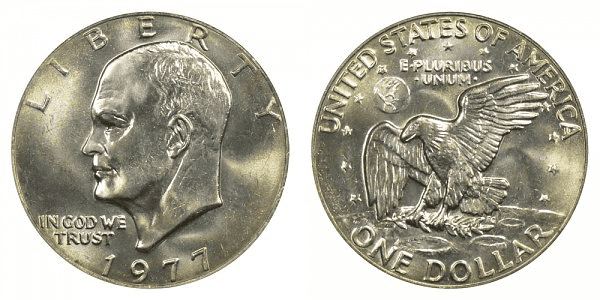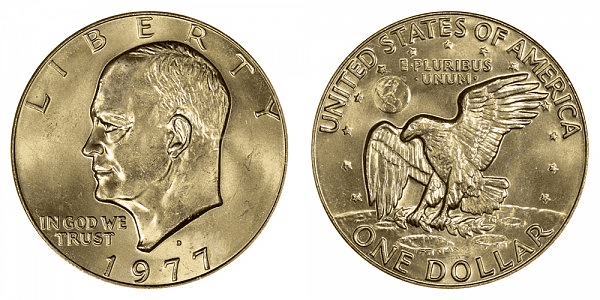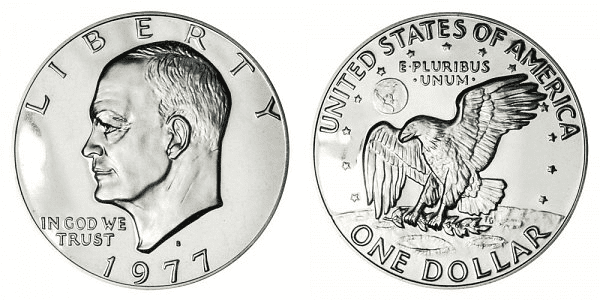What Makes A 1977 Eisenhower Dollar Valuable?
The general public’s desire for a dollar coin was hardly noticeable at the start of the 1970s. A replacement for the silver dollars that had been used to power tens of thousands of slot machines, however, had to be found fast by the gaming industry.
Due to this “need” and the recent passing of Dwight D. Eisenhower, a well-known war hero who later served as president, Congress had the opportunity to respond to the sector’s needs.
Although Congress ultimately agreed to employ the same copper-nickel (Cu-Ni) clad composition as the dime and quarter dollar, director of the United States Mint Mary Brooks had pushed for the money to be struck in silver.
Frank Gasparro’s portrayal of Dwight D. Eisenhower (as President), with the subject gazing to the left. The bust truncation reveals Gasparro’s elevated “FG” initials. Behind Eisenhower’s chin, on the left, is written, “IN GOD WE TRUST.” LIBERTY is shown around the top of the coin, between the rim and Eisenhower’s head, and the date is wrapped around the bottom of the image.
Coins made in Philadelphia lack a mintmark, whereas those struck in Denver and San Francisco have tiny “D” or “S” mintmarks above the area between the last two digits of the date. The hand-punched mintmarks of Eisenhower dollars may not always be in the same precise spot or position.
The reverse is based on the Michael Collins-designed Apollo 11 Mission Patch. The center features a bald eagle in descent. Its talons hold an olive branch. Its left wing is elevated. The lunar surface is down below. Over the eagle’s head, the Earth is depicted. One can clearly see North America.
Around the top of the coin, near the rim, are the words “UNITED STATES OF AMERICA.” Thirteen small five-point stars are arranged in a circle around the eagle. Above the eagle but below the ring of stars is the inscription “E PLURIBUS UNUM.” Around the bottom edge of the pattern, the word “ONE DOLLAR” is inscribed. The edge of the Eisenhower dollar from 1971-S7 is reeded.
The first Star Wars movie debuted in 1977, and the first Apple II computers were made available for purchase. At the same time as the first commercial aircraft from Concord took off, Elvis Presley, at 42, passed away
How Much Silver Is In A 1977 Eisenhower Dollar?
1977 Eisenhower dollars are silver in name, not in metallic content. You can tell whether your Ike dollar has silver content by checking out its date, and mint mark. 1971-S, 1972-S, 1973-S, and 1974-S are all silver-clad examples of this coin.
1977 Eisenhower Dollar Varieties
1971(Copper-Nickel clad) Silver dollar
Year: 1977
Denomination: One Dollar
Mint Mark: Philadelphia (no mint mark)
Mintage: 12,596,000
Composition: 91.67% Copper – 8.33% Nickel
Weight: 22.68 grams
Diameter: 38.1 mm
Edge: Plain

photo source: www.usacoinbook.com
1977-D Silver dollar
Year: 1977
Denomination: One Dollar
Mint Mark: Philadelphia (no mint mark)
Mintage: 32,983,006
Composition: 91.67% Copper – 8.33% Nickel
Weight: 22.68 grams
Diameter: 38.1 mm
Edge: Plain

photo source: www.usacoinbook.com
1977-S Silver dollar (uncirculated)
Year: 1977
Denomination: One Dollar
Mint Mark: Philadelphia (no mint mark)
Mintage: 3,251,152
Composition: 91.67% Copper – 8.33% Nickel
Weight: 22.68 grams
Diameter: 38.1 mm
Edge: Plain

photo source: www.usacoinbook.com
List of errors
There were a few rather amazing transitional mistakes committed with the 1977-D silver dollar. Although it is comprehensible that these 40% silver off-metal faults appeared soon after the US Mint stopped producing 1776–1976 Bicentennial Dollars with 40% silver blanks, such coins were actually minted at the San Francisco Mint.
Therefore, it is quite mysterious how these 1977-D silver dollar errors were made at the Denver Mint. Nevertheless, coin collectors prize them highly and consider them to be exceedingly valuable.
Some of the most well-known modern rarities are the 1977-D off-metal silver dollar errors. They are without a doubt some of the most expensive Eisenhower dollars.
The value of a 1977-D 40% silver dollar mistake ranges between $5,000 and $10,000. The specimen graded MS63 by Numismatic Guaranty Company that set the record price for one of these coins in 2014 sold for an astounding $12,925!
Other 1977 Eisenhower dollar errors, such as 1977 doubled die dollars, 1977 broadstrike dollars, and 1977 off-center dollars, should also be on the lookout for.
Depending on where and how much the die was doubled in 1977, the value of the coins can range from $50 to $100 or more. Any broadstrike dollar coin faults from 1977 are also desirable, with many of them fetching prices of $150 or higher.
One of the most valuable Ike dollar errors is the 1977 off-center errors, which typically sell for $500 to $1,000 each.
How Much Is A 1977 Eisenhower Silver Dollar Worth Today?
The majority of 1977 bills in circulation are worth between $1.10 and $1.25, therefore even the most used Ike bills are worth more than their face value! Uncirculated 1977 Eisenhower dollar coins often sell for between $4 and $10, with those in particularly fine mint state grades fetching even higher prices.
A specimen graded MS67 by Numismatic Guaranty Company sold for $3,600 in 2021, setting a record price for the most valuable 1977 dollar coin.
How Does The Grading System Work?
The Sheldon Scale is used by numismatists to provide a numerical value to coins. The Sheldon Scale goes from poor (P-1) to perfect mint state (P-1) (MS-70). Coins were originally evaluated using words to reflect their condition (Good, Fair, Excellent, Etc.). Unfortunately, coin collectors and dealers had different ideas about what each of these terms represent.
Professional numismatists joined together in the 1970s and established CoinGrading standards. These numismatists now assign grades at key places on the seventy-point scale, using the most regularly utilized numeric points in conjunction with the original adjective grade. The following are the most common coin grades:
-
-
- (P-1) Poor – Indistinguishable and probably damaged; if used, must have a date and mintmark; otherwise, rather battered.
- (FR-2) Fair – Nearly smooth, but without the damage that a coin graded Poor often possesses. The coin must have enough detail to be identified.
- (G-4) Fair – Inscriptions have merged into the rims in some areas, and important elements have been mostly erased.
- (VG-8) Very Good- A little weathered, but all of the primary design elements are visible, albeit faintly. There is little if any, central detail left.
- (F-12) Good – The item is very worn, yet the wear is even, and the overall design details stand out clearly. Rims are almost completely isolated from the field.
- (VF-20) Very Fine – Moderately weathered, with some finer features still visible. The motto or all letters of LIBERTY are readable. Both sides of the coin have entire rims that are separated from the field.
- (EF-40) Extremely Fine – Gently used; all gadgets are visible, and the most important ones are bold. The finer details are bold and clear, however, light wear may be seen.
- (AU-50) Uncirculated – Slight evidence of wear on the coin’s design’s high points; may have contact marks; eye appeal should be adequate.
- (AU-58) Uncirculated Choice – Slight traces of wear, no severe contact marks, almost full mint shine, and great eye appeal.
- (MS-60) Mint State Basal – Strictly uncirculated; no indication of wear on the coin’s highest points, but an unsightly coin with reduced luster, visible contact marks, hairlines, and other flaws.
- (MS-63) Mint State Acceptable – Uncirculated, but with contact scratches and nicks, little reduced shine, but otherwise appealing appearance. The strike is weak to average.
- (MS-65) Mint State Choice – Uncirculated with great mint shine, very little contact blemishes, and exceptional eye appeal. The strike is unusually severe.
- (MS-68) Mint State Premium Quality – Uncirculated with superb luster, no obvious contact marks to the naked eye, and exceptional eye appeal. The strike is quick and appealing.
- (MS-69) Almost Perfect Mint State – Uncirculated with perfect brilliance, a sharp and appealing strike, and extremely good eye appeal. A near-perfect coin with minor imperfections in the planchet, strike, and contact markings (seen only under 8x magnification).
- (MS-70) Mint State Perfect – Under 8x magnification, there are no tiny imperfections discernible; the strike is crisp, and the coin is perfectly centered on a beautiful planchet. Rarely seen on a coin, this coin is bright and whole, with original luster and exceptional eye appeal.
-
Where To Buy Or Sell 1977 Eisenhower Silver Dollar?
Because of their size and design, Eisenhower Silver dollars are popular with entry-level collectors and can therefore be quite commonly found on online marketplaces such as Etsy and eBay.
If you have a 1977 Eisenhower dollar that you think looks a little different and aren’t too clued up on what to look for, you might want to reach out to a coin collecting forum in order to double-check your coin isn’t more valuable than first thought.
FAQs
Where is the mint mark on a 1977 Eisenhower dollar?
The mint mark on the 1977 dollar coin is found below Eisenhower’s neck, on the obverse side of the coin.
Is a 1977 one-dollar coin silver?
No, the 1977 one-dollar coin is clad and doesn’t contain any silver.
How much is a 1977 Eisenhower uncirculated silver dollar worth?
Uncirculated Eisenhower dollars sell on average for between $4 and $10.



